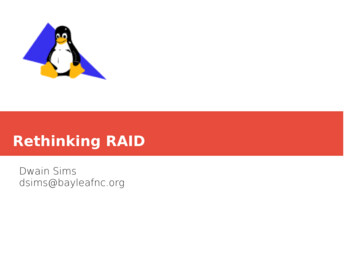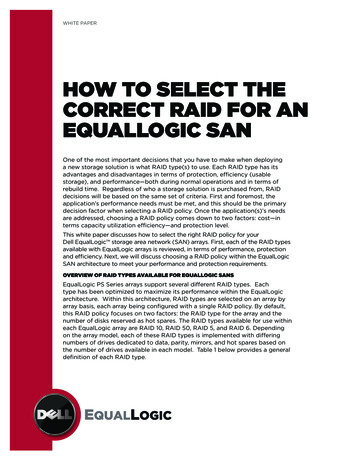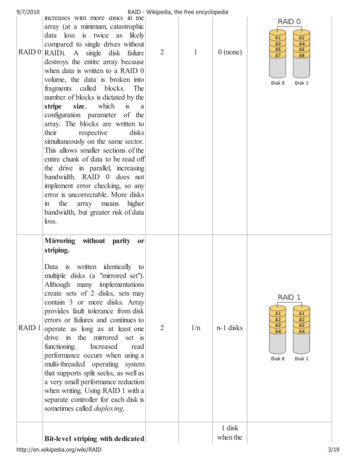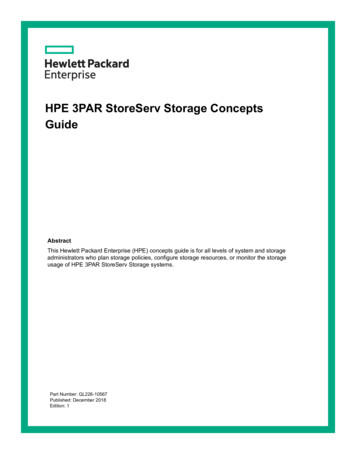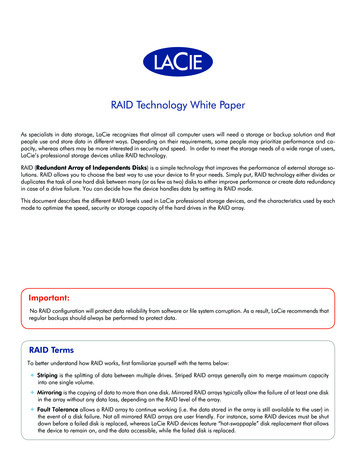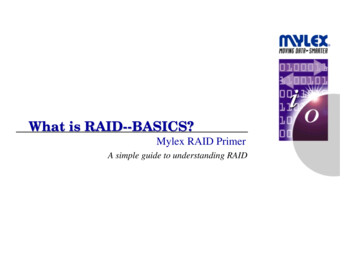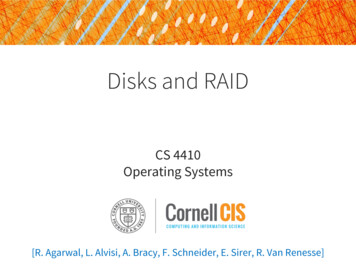
Transcription
Disks and RAIDCS 4410Operating Systems[R. Agarwal, L. Alvisi, A. Bracy, F. Schneider, E. Sirer, R. Van Renesse]
Storage Devices Magnetic disks (HDD) Flash drives (SSD)2
What do we want from storage? Fast: data is there when you want itReliable: data fetched is what you storedPlenty: there should be lots of itAffordable: won’t break the bank3
Magnetic Disks are 65 years old!THAT WAS THEN 13th September 1956 The IBM RAMAC 350 Total Storage 5 million characters(just under 5 MB)THIS IS NOW 2.5-3.5” hard drive Example: 500GB Western DigitalScorpio Blue hard drive easily up to a few of-computer-data-storage-in-pictures/4
RAM (Memory) vs. HDD (Disk) vs. SSD, 2020RAMTypical SizeCostLatencyThroughput(Sequential)Power RelianceHDDSSD16 GB1 TB1TB 5-10 per GB 0.05 per GB 0.10 per GB15 ns15 ms1ms8000 MB/s175 MB/s500 MB/svolatilenon-volatilenon-volatile5
Reading from diskSpindleHeadArmSurfaceMust specify:SectorPlatterSurface cylinder #(distance from spindle) head # sector # transfer size memory addressArmAssemblyTrackMotorMotor6
Disk TracksSpindleHeadArm 1 micron wide (1000 nm) Wavelength of light is 0.5 micronSurface Resolution of human eye: 50Plattermicrons 100K tracks on a typical 2.5” diskSectorSurfaceTrack length varies across disk Outside:- More sectors per track- Higher bandwidth Most of disk area in outer regions*not to scale: head is actually much bigger than a trackTrack*TrackMotorMotor7
Disk overheadsDisk Latency Seek Time Rotation Time Transfer Time Seek: to get to the track (5-15 millisecs (ms)) Rotational Latency: to get to the sector (4-8 millisecs (ms))(on average, only need to wait half a rotation) Transfer: get bits off the disk (25-50 microsecs (μs))SectorSeek TimeTrackRotationalLatency8
Disk SchedulingObjective: minimize seek timeContext: a queue of cylinder numbers (#0-199)Head pointer @ 53Queue: 98, 183, 37, 122, 14, 124, 65, 67Metric: how many cylinders traversed?9
Disk Scheduling: FIFO Schedule disk operations in order they arrive Downsides?FIFO Schedule?Total head movement?Head pointer @ 53Queue: 98, 183, 37, 122, 14, 124, 65, 6710
Disk Scheduling: Shortest Seek Time First Select request with minimum seek time fromcurrent head position A form of Shortest Job First (SJF) scheduling Not optimal: suppose cluster of requests at far endof disk starvation!SSTF Schedule?Total head movement?Head pointer @ 53Queue: 98, 183, 37, 122, 14, 124, 65, 6711
Disk Scheduling: SCANElevator Algorithm: arm starts at one end of disk moves to other end, servicing requests movement reversed @ end of disk repeatSCAN Schedule?Total head movement?Head pointer @ 53Queue: 98, 183, 37, 122, 14, 124, 65, 6712
Disk Scheduling: C-SCANCircular list treatment: head moves from one end to other servicing requests as it goes reaches the end, returns to beginning no requests serviced on return trip More uniform wait time than SCANC-SCAN Schedule?Total Head movement?(?)Head pointer @ 53Queue: 98, 183, 37, 122, 14, 124, 65, 6713
Solid State Drives (Flash)Most SSDs based on NAND-flash retains its state for months to years without powerMetal Oxide Semiconductor Field EffectTransistor (MOSFET)Floating Gate MOSFET ng-flash-floating-gates-and-wear/14
NAND FlashCharge is stored in Floating Gate(can have Single and Multi-Level Cells)Floating Gate MOSFET ng-flash-floating-gates-and-wear/15
Flash Operations Erase block: sets each cell to “1” erase granularity “erasure block” 128-512 KB time: several ms Write (aka program) page: can only write erasedpages write granularity 1 page 2-4KBytes time: 100s of microseconds Read page: read granularity 1 page 2-4KBytes time: 10s of microseconds Flash drive consists of several banks that can beaccessed in parallel Each bank can have thousands of blocks16
Flash Limitations can’t write 1 byte/word (must write whole blocks) limited # of erase cycles per block (memory wear) 103-106 erases and the cell wears out reads can “disturb” nearby words and overwrite them withgarbage Lots of techniques to compensate: error correcting codes bad page/erasure block management wear leveling: trying to distribute erasures across the entiredriver17
Flash Translation LayerFlash device firmware maps logical page #to a physical location Garbage collect erasure block by copying live pages tonew location, then erase- More efficient if blocks stored at same time are deleted atsame time (e.g., keep blocks of a file together) Wear-levelling: only write each physical page a limitednumber of times Remap pages that no longer work (sector sparing)Transparent to the device user18
Disk Failure Cases(1) Isolated Disk Sectors (1 sectors down, rest OK)Permanent: physical malfunction (magnetic coating,scratches, contaminants)Transient: data corrupted but new data can be successfullywritten to / read from sector(2) Entire Device Failure Damage to disk head, electronic failure, wear out Detected by device driver, accesses return error codes Annual failure rates or Mean Time To Failure (MTTF)19
What do we want from storage? Fast: data is there when you want itReliable: data fetched is what you storedPlenty: there should be lots of itAffordable: won’t break the bankEnter: Redundant Array of Inexpensive Disks (RAID) In industry, “I” is for “Independent” The alternative is SLED, single large expensive disk RAID RAID controller looks just like SLED to computer (yay,abstraction!)20
RAID-0Files striped across disks Fastlatency?throughput? Cheapcapacity?– Unreliablemax #failures?MTTF?Disk 0Disk 1stripe 0stripe 2stripe 4stripe 6stripe 8stripe 10stripe 12stripe 14stripe 1stripe 3stripe 5stripe 7stripe 9stripe 11stripe 13stripe 15.21
Striping and ReliabilityStriping reduces reliability More disks higher probability of some disk failing N disks: 1/Nth mean time between failures of 1 disk What can we do to improve Disk Reliability?22
RAID-1Disks Mirrored:data written in 2 places Reliabledeals well with disk lossbut not corruption Fastlatency?throughput?– ExpensiveDisk 0Disk 1data 0data 1data 2data 3data 4data 5data 6data 7data 0data 1data 2data 3data 4data 5data 6data 7.23
RAID-2bit-level striping with ECC codes 7 disk arms synchronized, move in unison Complicated controller ( very unpopular) Detect & Correct 1 error with no performance degradation Reliable– Expensiveparity 1 3 5 7 (all disks whose # has 1 in LSB, xx1)parity 2 3 6 7 (all disks whose # has 1 in 2nd bit, x1x)parity 4 5 6 7 (all disks whose # has 1 in MSB, 1xx)001Disk 1010Disk 2011Disk 3100Disk 4101Disk 5110Disk 6111Disk 7parity 1parity 4parity 7parity 2parity 5parity 8parity 3parity 6parity 9parity 10parity 11bit 1bit 5bit 9bit 13bit 2bit 6bit 10bit 14bit 3bit 7bit 11bit 15bit 4bit 8bit 12bit 16parity 1224
Throughput, Bandwidth, and Latency Throughput is usually measured in“number of operations per second” Bandwidth is usually measured in“number of bytes per second” Latency is usually measured in “seconds”Throughput and bandwidth are essentiallythe same thing, as each disk read/writeoperation transfers a fixed number of bytes(“block size”)27
Latency vs Throughput If you do one operation at a time, thenLatency Throughput 1. e.g., if it takes 100 ms to do a read or writeoperation, then you can do 10 operationsper second But operations can often be pipelined orexecuted in parallel throughput higher than 1/latency (road analogy)28
Sequential vs Random access With disks and file systems, sequentialaccess is usually much faster thanrandom access Reasons for faster sequential access: “fewer seeks” on the disk blocks can be “prefetched” updates of parity blocks can be amortizedacross multiple operations (“batching”)29
2 more rarely-used RAIDSRAID-3: byte-level striping parity disk read accesses all data disks write accesses all data disks parity disk On disk failure: read parity disk, compute missing dataRAID-4: block-level striping parity disk better spatial locality for disk accessDisk 1Disk 2Disk 3Disk 4Disk 5 Cheapdata 1data 2data 3data 4parity 1data 5data 6data 7data 8parity 2data 9data 10data 11data 12parity 3– Slow Writesdata 13data 14data 15data 16parity 4– Unreliableparity disk is write bottleneck and wears out faster30
Using a parity disk 𝐷! 𝐷" 𝐷# 𝐷! " XOR operation therefore 𝐷! 𝐷" 𝐷# 0 If one of 𝐷" 𝐷! " fails, we canreconstruct its data by XOR-ing all theremaining drives 𝐷 𝐷! 𝐷 %! 𝐷 &! 𝐷#31
Updating a block in RAID-4 Suppose block lives on disk 𝐷! Method 1: read corresponding blocks on 𝐷! 𝐷"# XOR all with new content of block write disk 𝐷 and 𝐷" in parallel Method 2: read 𝐷 (old content) and 𝐷"%% 𝐷" 𝐷" 𝐷 𝐷 % 𝐷 𝐷! 𝐷"# 𝐷 𝐷 % 𝐷 𝐷! 𝐷"# write disk 𝐷 and 𝐷" in parallel Either way: write throughput: ½ of single disk write latency: double of single disk32
Streaming update in RAID-4 Save up updates to stripe across 𝐷! 𝐷#%! Batching! Compute 𝐷# 𝐷! 𝐷" 𝐷#%! Write 𝐷! 𝐷# in parallel Throughput: (𝑁 1) times single disk Note that in all write cases 𝐷# must always beupdatedè 𝐷" is a write performance bottleneck33
RAID 5: Rotating Parity w/Striping Reliableyou can lose one disk Fast(𝑁 1) x seq. throughput of single disk𝑁 x random read throughput of single disk𝑁/4 x random write throughput AffordableDisk 0Disk 1Disk 2Disk 3Disk 4parity 0-3data 4data 8data 12data 16data 0parity 4-7data 9data 13data 17data 1data 5parity 8-11data 14data 18data 2data 6data 10parity 12-15data 3data 7data 11data 15data 19parity 16-1935
Enter: Redundant Array of Inexpensive Disks (RAID) In industry, "I" is for "Independent" . RAID-1 23 data 0 data 1 data 2 data 3 data 4 data 5 data 6 data 7 Disk 1. . . data 0 data 1 data 2 data 3 data 4 data 5 data 6 data 7 Disk 0. . . bit-level striping with ECC codes 7 disk arms synchronized, move in unison
